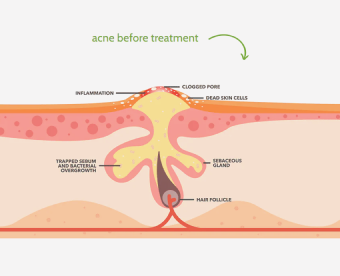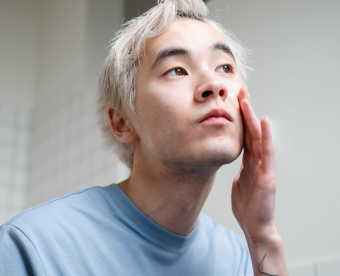Lamictal is a brand name for lamotrigine, commonly used to treat conditions like epilepsy and bipolar disorder. One of the potential side effects of taking lamotrigine is developing a skin rash or sometimes acne.
In rare cases, the rash may progress to life-threatening conditions like Stevens-Johnson Syndrome (SJS) and Toxic Epidermal Necrolysis (TEN). This article explores the early stages of lamictal rash or acne, focusing on symptoms, causes, treatments, and more.
Also read: How to choose the best acne treatment
Biggest Take-Aways:
- Lamotrigine (Lamictal) is a medication for seizure disorders but can lead to serious and potentially life-threatening rashes, requiring prompt treatment and careful monitoring.
- Recognizing early signs of a rash or reaction is vital, as side effects can happen anytime and may escalate quickly if not addressed.
- A holistic approach to treatment, including vigilant medical supervision, communication with healthcare providers, and a readiness to adjust dosages, ensures a safer and more effective treatment experience.
- Integrating Exposed Skin Care products can provide a supplemental approach to managing milder skin issues like acne without detracting from the importance of monitoring Lamictal's more serious side effects.

Symptoms of Early Stage Lamictal Rash or Acne
Understanding the early-stage lamictal rash or acne symptoms is vital to recognizing the condition quickly. Common symptoms include:
-
Mild Rash: Usually a red or purple rash that might feel itchy.
Peeling Skin: Affected skin may begin to peel or blister. - Flu-like Symptoms: Some individuals may experience flu-like symptoms, such as fever or fatigue.
Mild Rash
A mild rash is often the first sign that someone may develop a rash while taking lamotrigine. It usually appears within the first 8 weeks of treatment and can vary in appearance and sensation.
Peeling Skin and Blisters
Peeling skin and blisters can be more serious symptoms of early-stage lamictal rash. This can cause discomfort and require immediate attention.
Flu-like Symptoms
Along with the skin-related symptoms, some individuals might experience flu-like symptoms, adding complexity to the early diagnosis.

Causes of Early Stage Lamictal Rash or Acne
Understanding the underlying causes of early-stage lamictal rash or acne is essential for proper care and prevention. Various factors can contribute to this condition:
Taking a Higher Dose of Lamotrigine
Higher dosages of lamotrigine are more likely to cause a rash. This is especially common when a patient starts taking the medication and the body reacts to the new substance.
Combination with Other Medications
Certain medications, such as valproate or valproic acid, can interact with lamotrigine, increasing the risk of developing a rash. It's essential to be aware of these interactions and discuss them with healthcare providers.
Allergic Reaction to Lamotrigine
In rare cases, individuals may develop an allergic reaction to lamotrigine itself. This hypersensitivity reaction may lead to skin problems such as rashes or peeling.

Genetic Factors
Some studies suggest that genetic factors may play a role in developing a rash from lamotrigine. However, this area needs more research to understand fully.
Age Factor
Children aged 2 or below might be more susceptible to developing a rash from lamictal. Their skin is more sensitive, and their immune system is still developing.
Treatments for Early Stage Lamictal Rash or Acne
Treatment for early-stage lamictal rash or acne must be approached with caution and urgency. The specific course of action can vary based on the severity and underlying cause of the rash:
Stopping the Medication
The most immediate step is often to cease the intake of lamotrigine as soon as the rash occurs. It helps in preventing further escalation of the symptoms.
Using Corticosteroids
In some cases, corticosteroids may be prescribed to control inflammation and soothe the skin. It can be particularly effective if the rash has caused significant discomfort.
Monitoring and Supportive Care
Strict monitoring of the affected skin and general health is vital to prevent any further complications. Supportive care may include hydration, pain management, and skincare.
Alternative Medications
Alternative medications might be considered if the rash has developed due to an allergic reaction or other specific causes. It ensures that the underlying condition that lamotrigine is treating, such as epilepsy or bipolar disorder, continues to be managed effectively.
Treatment for Severe Cases
Hospitalization might be required in severe cases like Stevens-Johnson Syndrome or Toxic Epidermal Necrolysis. The treatment in these cases can be complex and may include intravenous fluids, wound care, and other intensive interventions.
Lifestyle and Home Remedies
For mild cases, soothing skincare routines and lifestyle changes might suffice. Using gentle cleansers, avoiding harsh skincare products, and staying hydrated can alleviate symptoms.

Stevens-Johnson Syndrome and Toxic Epidermal Necrolysis
Two severe complications of lamictal rash include Stevens-Johnson syndrome and toxic epidermal necrolysis. These conditions require immediate treatment and can become life-threatening.
Stevens-Johnson Syndrome (SJS)
SJS is a severe skin reaction that can cause blistering and peeling skin. Recognizing this condition in its early stages is vital.
Toxic Epidermal Necrolysis (TEN)
TEN is a more severe form of SJS, leading to widespread skin and mucous membrane damage.
Managing Acne with Exposed Skin Care: A Proactive Approach
While a serious rash from Lamictal, known as lamictal rash, is a side effect that may need urgent medical intervention, acne may develop as a less severe reaction. This is where Exposed Skin Care steps in.
Here are some reasons Exposed Skin Care can become an essential part of your daily skincare routine:
- Prevention of Serious Rash: Regularly using Exposed Skin Care may minimize the risk of developing a serious rash or lamotrigine-related skin rash.
- Quick Treatment for Acne: The products work to treat acne quickly, avoiding a severe reaction that could signal more significant skin problems.
- Minimizing Side Effects of Lamotrigine: Utilizing Exposed Skin Care products may help minimize the side effects of lamotrigine, specifically related to skin issues.
- Safe for People Taking Lamictal: The cohort of products is designed to be compatible with people taking Lamictal, as they follow strict sourcing guidelines and have been developed in alignment with academic research institutions.
It is important to monitor your skin's reaction to treatment with lamotrigine. Integrating Exposed Skin Care into your routine has benefits aligning well with the needs of those taking Lamictal.
Conclusion
It's crucial to understand that these effects can happen anytime, making it essential to pursue treatment quickly if they arise. The doctor may adjust the dose or take other measures to prevent complications.
Integrating products like Exposed Skin Care can help manage milder skin issues like acne, which lamotrigine can also cause. However, the main focus must remain on monitoring Lamictal's more serious side effects, ensuring that a minor issue doesn't escalate.
Understanding the complexities of treatment with Lamictal requires medical vigilance and constant communication with healthcare providers. Recognizing early signs of a reaction and responding promptly can make treatment more comfortable and safer.
This holistic approach, combining medical supervision with proactive skincare, provides a comprehensive strategy for those likely to develop side effects from Lamictal, ensuring both effective treatment of underlying conditions and care for the skin.
Lamotrigine, known as Lamictal, is used for seizure disorders but has serious side effects. A rash could develop, potentially becoming life-threatening, like dress syndrome.
Frequently Asked Questions (FAQs)
Q: What is Lamictal?
A: Lamictal is the brand name for lamotrigine, used to treat epilepsy and bipolar disorder.
Q: How likely is it to develop a rash while taking Lamictal?
A: While not common, a few people may develop a rash, especially during the first 8 weeks of starting the medication.
Q: What should I do if I experience a rash from Lamictal?
A: If you develop a rash while taking lamotrigine, contact your doctor immediately, and they may change your dose or advise youto stop taking the medication.
Q: Can Lamictal also cause acne?
A: While a rash is a common side effect of taking lamotrigine, acne is not commonly associated with this drug. However, any skin changes should be discussed with healthcare professionals.
Q: How can I learn to recognize early-stage lamictal rash or acne?
A: Recognizing early-stage lamictal rash or acne often relies on understanding the symptoms and regularly monitoring skin changes. Education from healthcare providers and informative resources like this article can aid in early recognition.


















